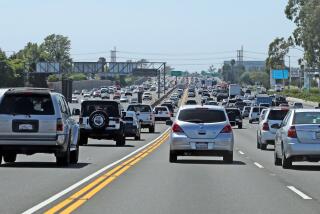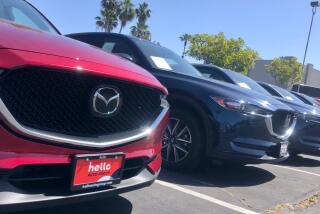Automakers vow to put the brakes on rear-end collisions
- Share via
Every 17 seconds, a driver on a U.S. road gets hit from behind. In fact, a third of all car crashes are rear-end collisions.
Traffic safety regulators, insurance companies and automakers have for years tried to figure out how to stop so many people from plowing into cars in front of them, accidents that result in deaths, injuries and millions of dollars in repairs and increased premiums.
Now comes a radical move to change all that. Ten of the world’s largest automakers — along with federal safety regulators and an insurance industry trade group — announced Friday that they will begin making automatic emergency braking a standard feature in future car models sold in the U.S.
The systems use on-vehicle sensors such as radar, cameras or lasers to detect an imminent crash, warn the driver and, if the driver doesn’t take action, engage the brakes.
“We are entering a new era of vehicle safety, focused on preventing crashes from ever occurring, rather than just protecting occupants when crashes happen,” said U.S. Transportation Secretary Anthony Foxx.
Audi, BMW, Ford, General Motors, Mazda, Mercedes-Benz, Tesla, Toyota, Volkswagen and Volvo each agreed to work with the National Highway Traffic Safety Administration to develop a timeline for installing automatic braking as a standard feature in all vehicles they sell in the U.S.
Those companies accounted for 57% of U.S. auto sales last year.
Friday’s announcement brings the rapidly changing auto industry one step closer to self-driving vehicles. Many cars are already available with automated features, including cruise control that speeds and slows with traffic, lane departure alerts with steering assistance and high beams that switch on in the absence of oncoming cars.
Making the automatic emergency braking systems standard will be an important advancement in motor vehicle safety, said Jake Fisher, automotive test director at Consumer Reports.
Robotic braking helps prevent or reduce the impact of rear-end collisions, which account for 33% of all crashes, according to the NHTSA. The Insurance Institute for Highway Safety, an insurance industry trade group, said its research found that automatic braking systems can reduce insurance injury claims by as much as 35%.
“Most crashes involve driver error. This technology can compensate for the mistakes every driver makes because the systems are always on alert, monitoring the road ahead and never getting tired or distracted,” IIHS President Adrian Lund said.
Sam Farina of Oxnard said the emergency system in his 2013 Subaru Outback once kicked in when a car in front of him braked suddenly.
“It reacted quicker than I did and might have saved me from an impact,” Farina said.
He paid extra for the option because he wanted an added layer of safety “especially in an era of more distracted driving with people texting.”
But Dick Tripp of El Paso, Texas, worries that robotic braking is not yet “ready for prime time.”
Tripp’s 2014 Honda Accord comes with sensors that flash lights and beep when he gets to close to a car.
“It is a good safety feature to have but I wouldn’t want it braking on me,” Tripp said. “It often mistakes parked cars or other fixed objects on curves as objects to be concerned about.”
As automatic braking finds its way into more vehicles, Consumer Reports will stop recommending cars that lack it, Fisher said.
Safety regulators and insurance industry representatives urged the remaining car and truck manufacturers to include the system in their vehicles as well. Nissan said in a statement that it was not asked to be included in the announcement, but planned to discuss the proposal with the NHTSA.
Honda said it had not joined the group. Honda charges an extra $1,000 for a safety package that includes automatic braking for its Accord sedan and Pilot sport-utility vehicle.
Exactly how automatic braking works depends on the manufacturer and the system. Some are effective at preventing crashes at the slower speeds cars drive in traffic, while others can work at nearly highway speeds.
NHTSA research found that a large number of drivers involved in rear-end crashes either did not apply the brakes at all or did not apply the brakes fully, failures that can be corrected by robotic braking.
“Automatic emergency braking is the next big safety feature on vehicles,” said Clarence Ditlow, executive director at the Center for Auto Safety. “It’s up there with electronic stability control and front and side air bags.”
It should be mandatory, Ditlow said, and held to federally regulated safety standards “with rigorous performance measures that trigger a recall if you don’t meet them.”
Consumer groups also should have the opportunity to weigh in, he said. “We go in and we raise the hard questions,” Ditlow said. “We would ask, if you are going to test the braking to make sure it stops a car going at 25 mph, then why not at 50 mph, which is closer to highway speeds?”
The NHTSA, with help from the insurance institute, will work with automakers on the details of the rollout, including timelines and performance criteria, said Gordon Trowbridge, the NHTSA’s spokesman.
“This is not an enforcement or a recall issue,” he said. “The companies are making this commitment in the absence of a federal mandate.”
Already, more cars are coming equipped with automatic braking. Mercedes-Benz offers a standard front-crash-prevention system in its 2015 C-Class, CLA and E-Class sedans. Volvo made low-speed automatic emergency braking standard on all its vehicles last year.
The IIHS said 52% of the 784 models in 2015 come with technology that alerts a driver to a pending crash as either a standard or optional feature.
Among the models, 27% also offer robotic braking. That’s more than twice as many as in the 2012 model year. But it’s often as an expensive option. Subaru, for example, offers the feature as part of a $2,595 package on its Impreza that also includes a moonroof and other amenities.
Although the insurance group has not measured the technology’s effect on premiums, it believes that fewer crashes will soon be reflected in lower rates, said Russ Rader, an IIHS spokesman.
But Janet Ruiz, spokeswoman for the Insurance Information Institute, said companies probably won’t lower rates until they have data showing fewer claims.
“Recently, loss frequency has been increasing as people are driving more miles. Overall, that increase has offset some of the improvement that recent technologies have brought,” she said.
Twitter:@latimesjerry
More to Read
Inside the business of entertainment
The Wide Shot brings you news, analysis and insights on everything from streaming wars to production — and what it all means for the future.
You may occasionally receive promotional content from the Los Angeles Times.











